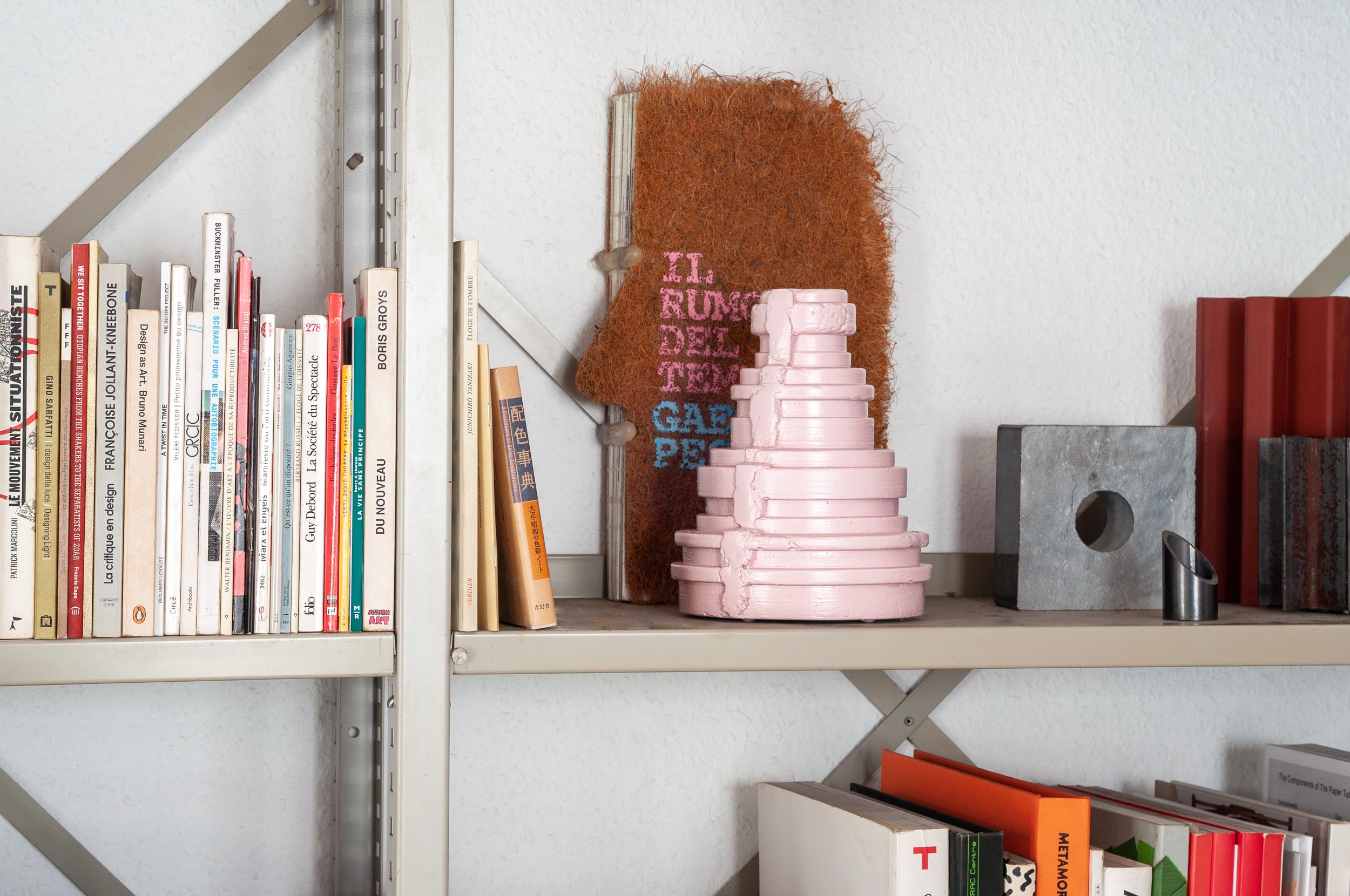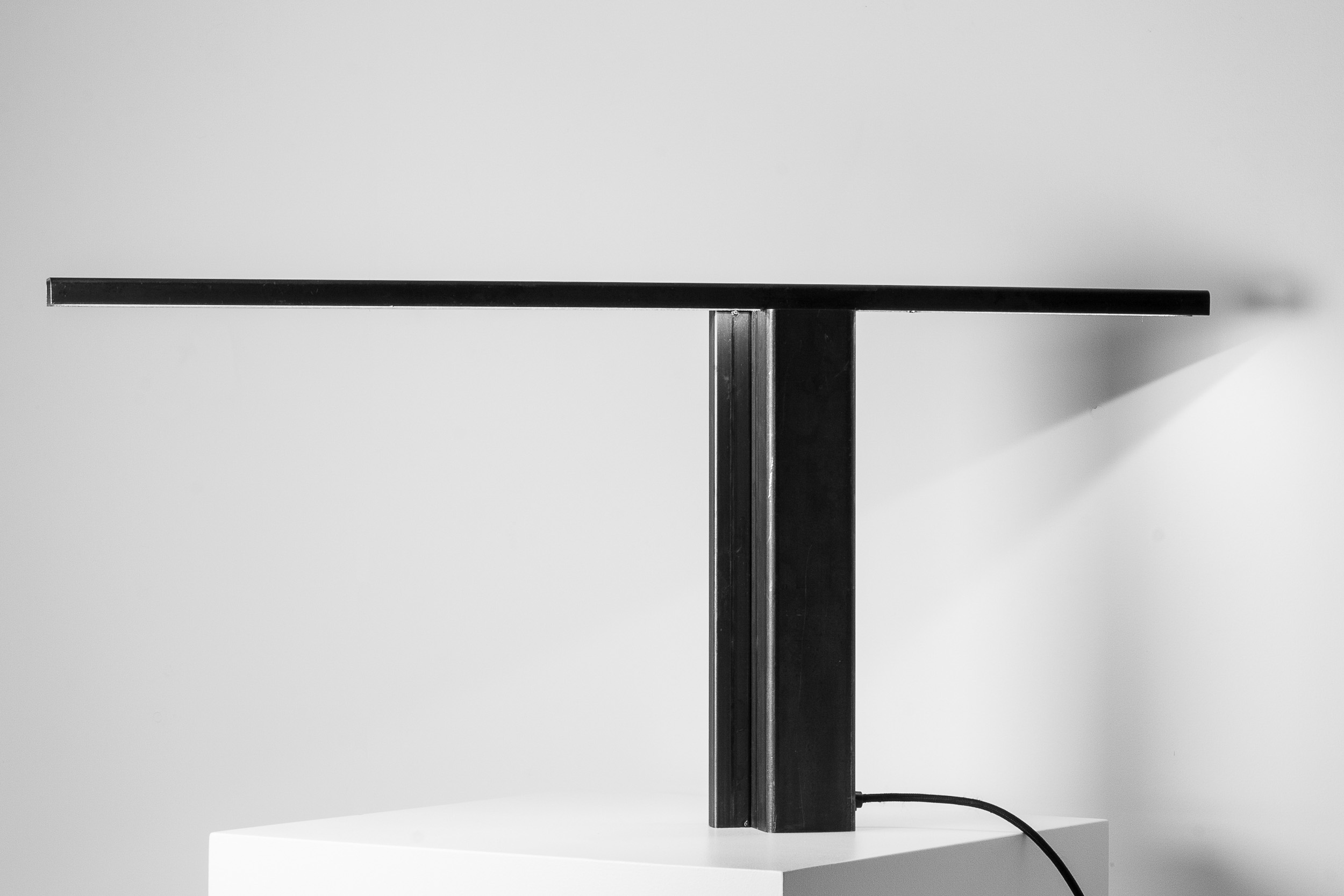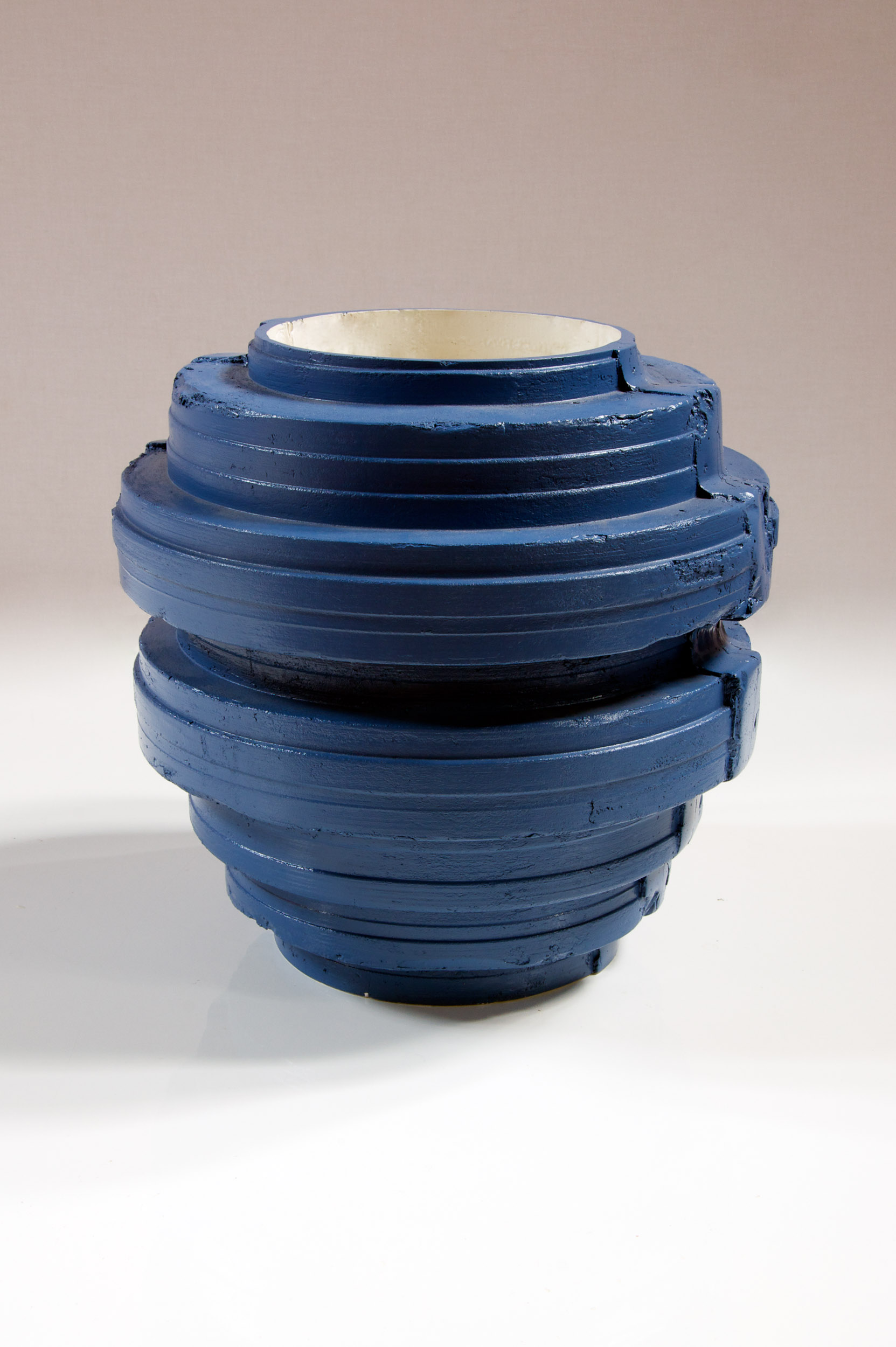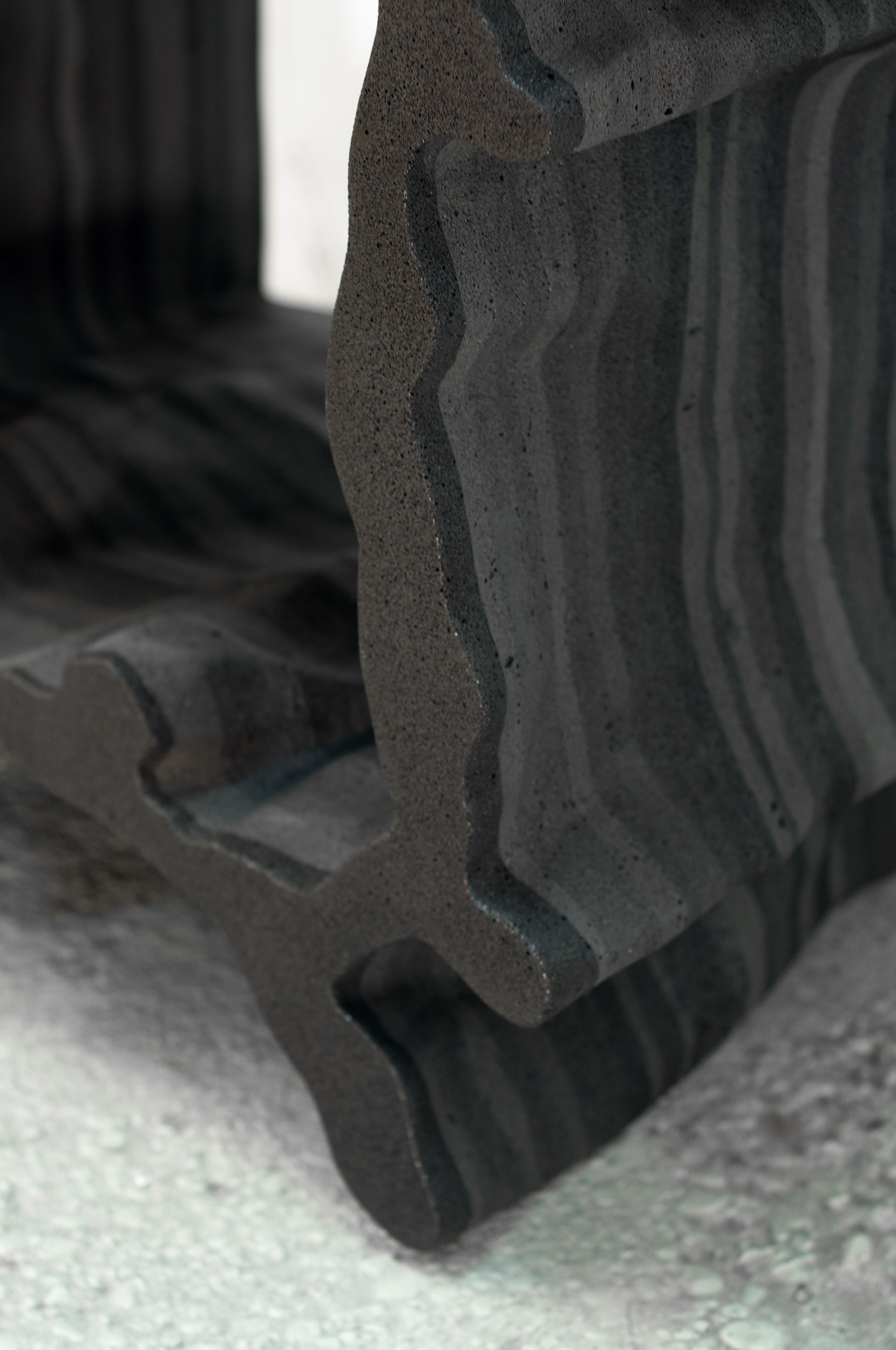Year: 2021
Edited by: A1043 gallery
Edition: 8 + 2AP
Materials: Lacquered plaster
Photographs: A1043 gallery
Acquisition: MAD - Musée des Arts Décoratifs, Paris, France
The Chunk collection is a play on color and materiality that exploits the plaster brittleness as an ornament instead of a sign of decay.
The Chunk vases are casted and painted prior to the breaking of their vertical edges. A ‘finish through breaking’ inspired by American modernist architect Paul Rudolph’s corduroy technique.











Year: 2020
Edited by: Studio Julien Carretero
Edition: Numbered
Materials: Brushed aluminium
Conceived and produced during the Covid pandemic, the radicality of the ALU Chair comes as a result from the odd period during which it was designed.
The deprivation of suppliers as well as the obvious constraints brought by the confinement were turned into an opportunity to work differently than usual by upcycling leftover materials from previous projects the studio had been working on in the past.
The straightforwardness of the ALU Chair therefore reflects the context within which it was created.



Year: 2019
Edited by: Studio Julien Carretero
Edition: 99 + 2AP
Materials: Lacquered plaster
Photographs: Jeroen Verrecht, Julien Carretero
Retailer: MATTER (NYC)
Drag2 deals with a production process inspired by the traditional plaster dragging technique in wich the plaster is constrained in shape by a profile while hardening.
This technique traditionally used to produce ornamental cornices is adapted here to produce various typologies of objects thanks to a system of combinatory molds made after genuinely dragged models. Seven molds that once combined give birth to this collection of 24 pieces that includes vases, pendant lamps, sconces and bowls.
All Drag2 pieces are made in Belgium by Studio Julien Carretero.










































Year: 2017
Event: Salone del Mobile
Commissioner: IN Residence
Curators: Barbara Brondi & Marco Rainò
Location: Palazzo Clerici, Milan, Italy
Material: Aluminum
Stoicheion was commissioned by IN Residence to be part of Talisman, Contemporary Symbolic Objects, an exhibition gathering talismans designed by 46 designers held during the Milan Design Week 2017 at Palazzo Clerici.
Stoicheion is a portable adaptation of the periodic table that arranges chemical elements according to their atomic number, electron configurations and chemical properties.
Complex to decode for novices it represents the ultimate agnostic talisman par excellence. Its ‘magic’ stands in its ability to deconstruct and summarize down to 118 elements all things existing — both natural and artificial —, all living beings as well as all phenomenons happening — known and unknown — in the Universe. The extraordinary power of Stoicheion therefore relies on the intriguing alphabet it depicts, which can be considered as the most complete list of ingredients from which all recipes can be achieved.
Stoicheion was commissioned by IN Residence to be part of Talisman, Contemporary Symbolic Objects, an exhibition gathering talismans designed by 46 designers held during the Milan Design Week 2017 at Palazzo Clerici.
In 440 BC Democritus initiated the idea of the atom as an indivisible particle that all matter is made of. Nonetheless the 7th row of the periodic table of elements as we know it, which was initiated by chemist Dmitri Mendeleev in 1869, had remained incomplete until late 2016 when the discovery of the four missing chemical elements as well as their names was officially announced.
Stoicheion is therefore the most complete version of the periodic table made to date.

Year: 2015
Event: Design Miami
Commissioner: Caroline van Hoek
Location: Miami, USA
Materials: Steel profiles, LEDs, electrical components
Photographs : Charlotte Dumoncel d’Argence
Exhibition photographs: James Harris
Profiles is a series of six unique lamps commissioned by gallery Caroline van Hoek as a scenographic ensemble to highlight its contemporary jewellery collection on international fairs such as Design Miami/ Basel.
It is designed to become an alternative to the lighting systems provided on such fairs and allow the gallery to become independent on both aesthetic and functional aspects of its booth.
Each lamp is made from different steel profile sections subtly assembled together to create minimalistic combinations that aim to mend with the identity of the gallery as well as to light up intensely the artists works without dazzling visitors.










Year: 2013
Producer: Victor Hunt
Project assistant: Sarah LaaroussiMaterials: Lacquered and brushed stainless steel, LEDs, electrical components
Campaign pictures: Laetitia Bica
Catalog: Theophile’s Papers
Project assistant: Sarah Laaroussi
Contrast explores the inherent physical characteristics within various metals such as bronze, copper, brass, aluminum, carbon or stainless steel. It is a play on weights, colours, textures and light using industrially produced pipes as raw material.
A simple plane cut is processed in order to convert these elementary industrial supplies into different lighting object typologies. These either CNC-milled, laser-cut or crafted openings reveal the insides of the pipes in opposition to their outsides. The tension created is reinforced through the use of numerous surface treatments ranging from industrial ones such as lacquering, anodizing, polishing and brushing to crafted patinas and natural oxidations.



Year: 2013
Producer: Victor Hunt
Project assistant: Sarah Laaroussi
Materials: Lacquered and darkened steel, LEDs, electrical components
Campaign pictures: Laetitia Bica
Catalog: Theophile’s Papers
Project assistant: Sarah Laaroussi
Contrast explores the inherent physical characteristics within various metals such as bronze, copper, brass, aluminum, carbon or stainless steel. It is a play on weights, colours, textures and light using industrially produced pipes as raw material.
A simple plane cut is processed in order to convert these elementary industrial supplies into different lighting object typologies. These either CNC-milled, laser-cut or crafted openings reveal the insides of the pipes in opposition to their outsides. The tension created is reinforced through the use of numerous surface treatments ranging from industrial ones such as lacquering, anodizing, polishing and brushing to crafted patinas and natural oxidations.


Year: 2013
Producer: Victor Hunt
Project assistant: Sarah Laaroussi
Materials: Lacquered and mirror-polished stainless steel, LEDs, electrical components
Campaign pictures: Laetitia Bica
Catalog: Theophile’s Papers
Project assistant: Sarah Laaroussi
Contrast explores the inherent physical characteristics within various metals such as bronze, copper, brass, aluminum, carbon or stainless steel. It is a play on weights, colours, textures and light using industrially produced pipes as raw material.
A simple plane cut is processed in order to convert these elementary industrial supplies into different lighting object typologies. These either CNC-milled, laser-cut or crafted openings reveal the insides of the pipes in opposition to their outsides. The tension created is reinforced through the use of numerous surface treatments ranging from industrial ones such as lacquering, anodizing, polishing and brushing to crafted patinas and natural oxidations.



Year: 2013
Producer: Victor Hunt
Project assistant: Sarah LaaroussiMaterials: Brass and bronze with traditional patinas / nickeled steel and brushed and mirror-polished aluminium, LEDs, electrical components.
Campaign pictures: Laetitia Bica
Catalog: Theophile’s Papers
Project assistant: Sarah Laaroussi
Contrast explores the inherent physical characteristics within various metals such as bronze, copper, brass, aluminum, carbon or stainless steel. It is a play on weights, colours, textures and light using industrially produced pipes as raw material.
A simple plane cut is processed in order to convert these elementary industrial supplies into different lighting object typologies. These either CNC-milled, laser-cut or crafted openings reveal the insides of the pipes in opposition to their outsides. The tension created is reinforced through the use of numerous surface treatments ranging from industrial ones such as lacquering, anodizing, polishing and brushing to crafted patinas and natural oxidations.








Year: 2013
Producer: Victor Hunt
Project assistant: Sarah LaaroussiMaterials: Anodized aluminium, mirror-polished brass, brushed copper with patina, mirror-polished stainless steel, corten steel, LEDs, electrical components.
Campaign pictures: Laetitia Bica
Catalog: Theophile’s Paper’s
Project assistant: Sarah Laaroussi
Contrast explores the inherent physical characteristics within various metals such as bronze, copper, brass, aluminum, carbon or stainless steel. It is a play on weights, colours, textures and light using industrially produced pipes as raw material.
A simple plane cut is processed in order to convert these elementary industrial supplies into different lighting object typologies. These either CNC-milled, laser-cut or crafted openings reveal the insides of the pipes in opposition to their outsides. The tension created is reinforced through the use of numerous surface treatments ranging from industrial ones such as lacquering, anodizing, polishing and brushing to crafted patinas and natural oxidations.














Year: 2013
Commissioner: Victor Hunt
Location: MAD (Brussels Fashion and Design Center), Belgium
Materials: Timber wood, waterproof MDF, screws.
Pop-up is a system of furniture that was originally created for a temporary bar / restaurant organized by gallery Victor Hunt and the MAD (Brussels Fashion and Design Center) during Art Brussels 2013.
It was designed in order to be adaptable in length, witdth and height as well as to be directly ordered to any wood supplier shop and to be time-saving in construction. It is entirely made from standard timber wood and does not require any angle-cuts or carpentry work to be assembled. Beams are only cut in length so that they can be ordered to size and mounted together with standard screws by anyone. The flexible zig-zag structure is then made rigid thanks to the MDF tops.






Year: 2011
Edition: Studio Julien Carretero
Production site: Beeldenstorm
Materials: casted aluminium, varnished waterproof MDF, birch veneer (lamp)
Project assistants: Sabine Roth, Lauren Tortil, Jason Page, Vincent Tarisien, Paulo Sellmayer, Anaïck Lejart, Geoffroy Gillant
The Stencil collection is the first series of aluminium pieces of furniture ever casted in fabric. It is the result of an experimental research aiming at turning the complex aluminium casting technique into a flexible and low-cost system of production. In order to do so, the number of steps required along the process is reduced to its minimum and the need for complex and expensive infrastructures is avoided. Economic flexibility arises from the lightness of the method that encourages locally set production facilities. Whereas technical flexibility is brought through the use of extremely basic and low-cost re-usable mould systems made from raw flat materials. High-temperature resistant fabric is clamped in a steel stencil and the fused aluminum is poured into it. Unlike usual metal casting processes, once the mould is unclamped and the piece released, it can instantly be reused for another casting. This process does not create any waste as the aluminum left overs can be melted down and the fabric reused over and over.












Year: 2010
Event: Dutch Design Week 2010
Commissioner: Dutch Invertuals
Curator: Wendy Plomp
Location: Eindhoven, Netherlands
Exhibition pictures: Raw Color
Excavation pictures: Laurens Mulkens
Project assistants: Paulo Sellmayer, Anaïck Lejart, Geoffroy Gillant
In Situ is part of the Matter of Time exhibition organized by the design collective Dutch Invertuals.
In Situ is a series of objects made of recently excavated wood from Eindhoven’s Medieval city wall. After more than 600 years underground, the oak wood that was once used to protect the city is brought back to the public space in the form of instruments for revolution. Their intervention aims to question and challenge the routine taking place in cityscapes. Through the creation of situations of wonder, In Situ wants to break public passivity and encourage passers-by to actively participate to the spectacle of daily life. The In Situ props, which all share the symbolic value of both escape and uprising, interact with wanderers on various levels: may these be physical, visual, narrative or emotional.
In situ wants to unleash feelings and people.
In Situ is a trigger.
























Year: 2009
Edited by: Studio Julien Carretero
Materials: lacquered synthetic plaster
Project assistants: Chloé Pouzoulet, Sabine Roth
Acquisition: CNAP - Fonds National d’Art Contemporain, France
Drag deals with a production process inspired by the traditional plaster dragging technique in wich the plaster is constrained in shape by a profile while hardening. This technique traditionally used to produce ornamental cornices is adapted here in order to serially produce various typologies of objects thanks to a single apparatus. The process results in an infinite variation of shapes, all based on solids of revolution.
Multiple sizes of semi-circular shapes are aligned on the central axe of the apparatus, which drags the plaster on top of them. The two halves of the object are then assembled together by using the overload of dragged material.
































PROCESS









Year: 2008
Commissioner: Villa Noailles, Hyères, France
Materials: stainless steel, polyester strap, electrical engine, PP
Project assistant: Camille Cortet
This Is a Fan deals with the integration of an electric appliance within the domestic landscape. Fans which can be found in every machines of different scales from computers to cars find their function in the habitat thanks to the cage they are covered by, designed according to safety regulations.
Because a protective cage is needed, the cage of This Is a Fan is designed in order to value the beauty of its mechanical elements as well as to allow their assembly. The cage becomes a vitrine and the naked engine and propeller, strapped inside, become alive.





Year: 2007
Material: Polyurethane composite
To Be Continued deals with creating a real and recognizable uniqueness within serial production. Instead of leaving randomness manage the differences, it uses the repetitive actions existing within the production process as a tool for differentiation. Each piece produced comes as a result of a process applied on the piece that came before. Each piece is then existing because of the others and couldn’t have been designed without the others.
Each layer is casted on top of the one casted before following the exact outline of it. Because of the imperfection of the cast, the object slowly mutates and start designing itself.










